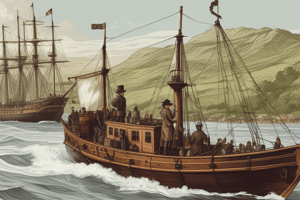Podcast
Questions and Answers
What was the main focus of the Reform Act of 1832?
What was the main focus of the Reform Act of 1832?
- Empowering the aristocracy
- Protecting property
- Expanding suffrage (correct)
- Creating democracy
What did the Reform Act of 1832 not achieve?
What did the Reform Act of 1832 not achieve?
- Empowerment of the working class
- Universal male suffrage (correct)
- Protection of property
- Creation of democracy
What was the primary goal of the Chartist movement?
What was the primary goal of the Chartist movement?
- Universal male suffrage (correct)
- Protection of property
- Creation of democracy
- Empowerment of the aristocracy
What event led to the government's hostility towards working-class movements?
What event led to the government's hostility towards working-class movements?
What were the six points of Chartism?
What were the six points of Chartism?
What was the significance of the pay for members of parliament point in Chartism?
What was the significance of the pay for members of parliament point in Chartism?
Why were the entrenched classes, both liberal and conservative, wary of democracy?
Why were the entrenched classes, both liberal and conservative, wary of democracy?
What did the Chartists want to achieve through the People's Charter?
What did the Chartists want to achieve through the People's Charter?
What was the impact of the Reform Act of 1832 on property requirements for voting?
What was the impact of the Reform Act of 1832 on property requirements for voting?
What was the government's response to the working-class protest known as the Peterloo massacre?
What was the government's response to the working-class protest known as the Peterloo massacre?
What was the timeframe of the Chartist movement's operation?
What was the timeframe of the Chartist movement's operation?
What was the primary concern of the working class in relation to suffrage?
What was the primary concern of the working class in relation to suffrage?
Which law aimed to address labor issues was passed in response to the Chartist movement?
Which law aimed to address labor issues was passed in response to the Chartist movement?
What was the estimated attendance at the Chartist meeting in 1848 according to the government?
What was the estimated attendance at the Chartist meeting in 1848 according to the government?
What was the government's response to the Chartist movement?
What was the government's response to the Chartist movement?
What was the impact of the Chartist movement on legislative changes?
What was the impact of the Chartist movement on legislative changes?
What was the Chartist movement's legacy in England?
What was the Chartist movement's legacy in England?
What was Frederick Engels' view of the Chartist movement's decline?
What was Frederick Engels' view of the Chartist movement's decline?
What was the Chartist movement's impact on labor laws?
What was the Chartist movement's impact on labor laws?
How did the upper classes respond to the Chartist movement?
How did the upper classes respond to the Chartist movement?
What characterized the Chartist movement's tactics?
What characterized the Chartist movement's tactics?
What did the Chartist movement pave the way for?
What did the Chartist movement pave the way for?
What was the ultimate impact of the Chartist movement?
What was the ultimate impact of the Chartist movement?
Flashcards are hidden until you start studying
Study Notes
The Chartist Movement and Its Impact
- The Chartist movement in England from 1838 to 1848 aimed at political reform and had six demands, including universal male suffrage and annual elections to Parliament.
- The movement engaged in peaceful demonstrations as well as violent clashes with authorities, and it sought to address the grievances of the working class.
- The Chartist meeting in 1848 drew conflicting estimates of attendance, with the Chartists claiming over 300,000 people, the government estimating 15,000, and the newspaper estimating around 50,000.
- The Chartists' demands were not immediately met, but over time, all demands except for annual elections to Parliament were implemented.
- In response to the Chartist movement, Parliament passed three laws: the Mines Act in 1842, the repeal of the Corn Laws in 1846, and the Ten-Hour Act in 1847, which aimed to address labor issues.
- Frederick Engels, known for his work with Karl Marx, expressed disappointment with the movement's decline and the focus on superficial reforms rather than the people's charter.
- The movement's impact led to reform from above, with the upper classes voluntarily enacting changes to prevent radical agitation.
- The Chartist movement represented a significant push for political and social change in England during the early 19th century.
- The movement's demands and tactics, including peaceful demonstrations and engagement with the working class, shaped the political landscape and led to legislative changes.
- The Chartist movement's legacy is evident in the eventual implementation of its demands, signaling a shift in the relationship between the ruling and working classes in England.
- The movement's influence on labor laws and political reform demonstrates the power of grassroots movements in shaping government policies.
- The Chartist movement's impact extended beyond its immediate demands, paving the way for ongoing social and political changes in England.
Studying That Suits You
Use AI to generate personalized quizzes and flashcards to suit your learning preferences.




